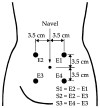Assessment of Dispersion and Bubble Entropy Measures for Enhancing Preterm Birth Prediction Based on Electrohysterographic Signals
- PMID: 34577278
- PMCID: PMC8471282
- DOI: 10.3390/s21186071
Assessment of Dispersion and Bubble Entropy Measures for Enhancing Preterm Birth Prediction Based on Electrohysterographic Signals
Abstract
One of the remaining challenges for the scientific-technical community is predicting preterm births, for which electrohysterography (EHG) has emerged as a highly sensitive prediction technique. Sample and fuzzy entropy have been used to characterize EHG signals, although they require optimizing many internal parameters. Both bubble entropy, which only requires one internal parameter, and dispersion entropy, which can detect any changes in frequency and amplitude, have been proposed to characterize biomedical signals. In this work, we attempted to determine the clinical value of these entropy measures for predicting preterm birth by analyzing their discriminatory capacity as an individual feature and their complementarity to other EHG characteristics by developing six prediction models using obstetrical data, linear and non-linear EHG features, and linear discriminant analysis using a genetic algorithm to select the features. Both dispersion and bubble entropy better discriminated between the preterm and term groups than sample, spectral, and fuzzy entropy. Entropy metrics provided complementary information to linear features, and indeed, the improvement in model performance by including other non-linear features was negligible. The best model performance obtained an F1-score of 90.1 ± 2% for testing the dataset. This model can easily be adapted to real-time applications, thereby contributing to the transferability of the EHG technique to clinical practice.
Keywords: bubble entropy; dispersion entropy; electrohysterography; feature selection; fuzzy entropy; genetic algorithm; preterm birth prediction; sample entropy; uterine electrical activity; uterine electromyogram.
Conflict of interest statement
The authors declare no conflict of interest.
Figures





Similar articles
-
Enhancing classification of preterm-term birth using continuous wavelet transform and entropy-based methods of electrohysterogram signals.Front Endocrinol (Lausanne). 2023 Jan 10;13:1035615. doi: 10.3389/fendo.2022.1035615. eCollection 2022. Front Endocrinol (Lausanne). 2023. PMID: 36704040 Free PMC article.
-
Novel Multichannel Entropy Features and Machine Learning for Early Assessment of Pregnancy Progression Using Electrohysterography.IEEE Trans Biomed Eng. 2022 Dec;69(12):3728-3738. doi: 10.1109/TBME.2022.3176668. Epub 2022 Nov 21. IEEE Trans Biomed Eng. 2022. PMID: 35604992
-
Optimized Feature Subset Selection Using Genetic Algorithm for Preterm Labor Prediction Based on Electrohysterography.Sensors (Basel). 2021 May 12;21(10):3350. doi: 10.3390/s21103350. Sensors (Basel). 2021. PMID: 34065847 Free PMC article.
-
Electrohysterography in the diagnosis of preterm birth: a review.Physiol Meas. 2018 Feb 26;39(2):02TR01. doi: 10.1088/1361-6579/aaad56. Physiol Meas. 2018. PMID: 29406317 Review.
-
Accuracy of frequency-related parameters of the electrohysterogram for predicting preterm delivery: a review of the literature.Obstet Gynecol Surv. 2009 Aug;64(8):529-41. doi: 10.1097/OGX.0b013e3181a8c6b1. Obstet Gynecol Surv. 2009. PMID: 19624864 Review.
Cited by
-
Adaptive Filtering for the Maternal Respiration Signal Attenuation in the Uterine Electromyogram.Sensors (Basel). 2022 Oct 9;22(19):7638. doi: 10.3390/s22197638. Sensors (Basel). 2022. PMID: 36236736 Free PMC article.
-
An open dataset with electrohysterogram records of pregnancies ending in induced and cesarean section delivery.Sci Data. 2023 Oct 2;10(1):669. doi: 10.1038/s41597-023-02581-6. Sci Data. 2023. PMID: 37783671 Free PMC article.
-
Enhancing classification of preterm-term birth using continuous wavelet transform and entropy-based methods of electrohysterogram signals.Front Endocrinol (Lausanne). 2023 Jan 10;13:1035615. doi: 10.3389/fendo.2022.1035615. eCollection 2022. Front Endocrinol (Lausanne). 2023. PMID: 36704040 Free PMC article.
-
Combination of Feature Selection and Resampling Methods to Predict Preterm Birth Based on Electrohysterographic Signals from Imbalance Data.Sensors (Basel). 2022 Jul 7;22(14):5098. doi: 10.3390/s22145098. Sensors (Basel). 2022. PMID: 35890778 Free PMC article.
-
Peak amplitude of the normalized power spectrum of the electromyogram of the uterus in the low frequency band is an effective predictor of premature birth.PLoS One. 2024 Sep 12;19(9):e0308797. doi: 10.1371/journal.pone.0308797. eCollection 2024. PLoS One. 2024. PMID: 39264880 Free PMC article.
References
-
- Mandy G.T. Short-term complications of the preterm infant. UpToDate. 2019;46:1–17.
MeSH terms
Grants and funding
LinkOut - more resources
Full Text Sources

